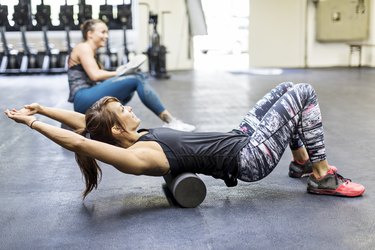
Foam rollers are an effective rehab and training tool, available in a variety of sizes, materials and densities. Daily foam roller neck exercises facilitate postural alignment of the neck and provide pain relief by focusing on tight knots or bands within neck muscles.
Some foam roller neck exercises you can try incorporate cervical stretching, strengthening and stability exercises, as well as self-massage and myofascial release.
Video of the Day
Video of the Day
Causes of Neck Pain
There can be a variety of causes for neck pain, including daily habits such as looking down at a smartphone or a computer monitor or slumping over while sitting or driving. Looking down and rounding your shoulders forces your neck to flex forward.
Over time, this repetitive movement can cause chronic neck pain. In such cases, foam rolling allows for myofascial release of the fascia, the thin layer of connective tissue that surrounds muscles and other bodily structures.
Note that foam rolling should be slightly uncomfortable but not overly painful. If you experience significant pain while foam rolling, or if your neck pain has lasted for more than a week or two without improvement, visit your primary care doctor for a thorough evaluation. There can be other, more serious causes of neck pain that would require proper diagnosis and medical attention, including arthritis, neck bone spurs, ruptured spinal discs, fractures, scoliosis and old whiplash injuries.
Foam Roller Neck Exercises
If your neck pain is in the back of your neck, lay flat on your back, and place the foam roller sideways under your neck. Keep your head up and lift your hips off the floor slowly until all your weight is on your neck muscles. You may want to turn your head slowly from side to side so the roller is hitting muscle tissue, not bone.
Very little actual rolling is involved with the neck; rather the roller is placed under a sensitive or knotted spot and the pressure on that spot is gradually increased, remaining there until it releases, but no longer than a minute. To move higher, lift your neck off the roller and place it back down just above the previous spot.
For the side of your neck, lay down on your side, and place the roller sideways under your neck. Again, slowly lift your hips until most of your weight is on the side of your neck. Stop if the area is too painful and only put as much weight on your neck as is comfortable. Make sure to do both sides of your neck to maintain balance.
Read more: The Dos and Don'ts of Foam Rolling
Roll Shoulders and Upper Back
Tightness or rounding in the shoulders and upper back can radiate into your neck. Lay the foam roller flat on the floor and sit on one end of it. Lay back so the roller is under your spine longways, in a parallel direction. Roll side-to-side slowly over the roller while maintaining an imaginary glass of water on your stomach without spilling it.
Gradually increase your range of motion as you get more comfortable and balanced. Focus on the muscles in between your shoulder blades and up to the base of your neck until you find the knots and then roll them out. Turning your head in the opposite direction from the movement of your pelvis will allow for additional stretching of the neck muscles.
In addition to foam roller neck exercises, you can also perform exercises that strengthen the muscles in your upper back. By exercising your rhomboids and trapezius muscles, you will improve your posture and reduce neck pain.